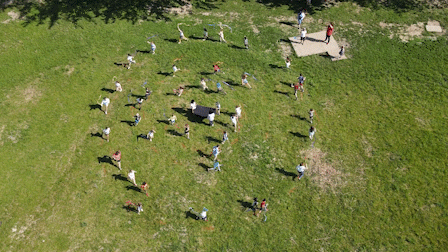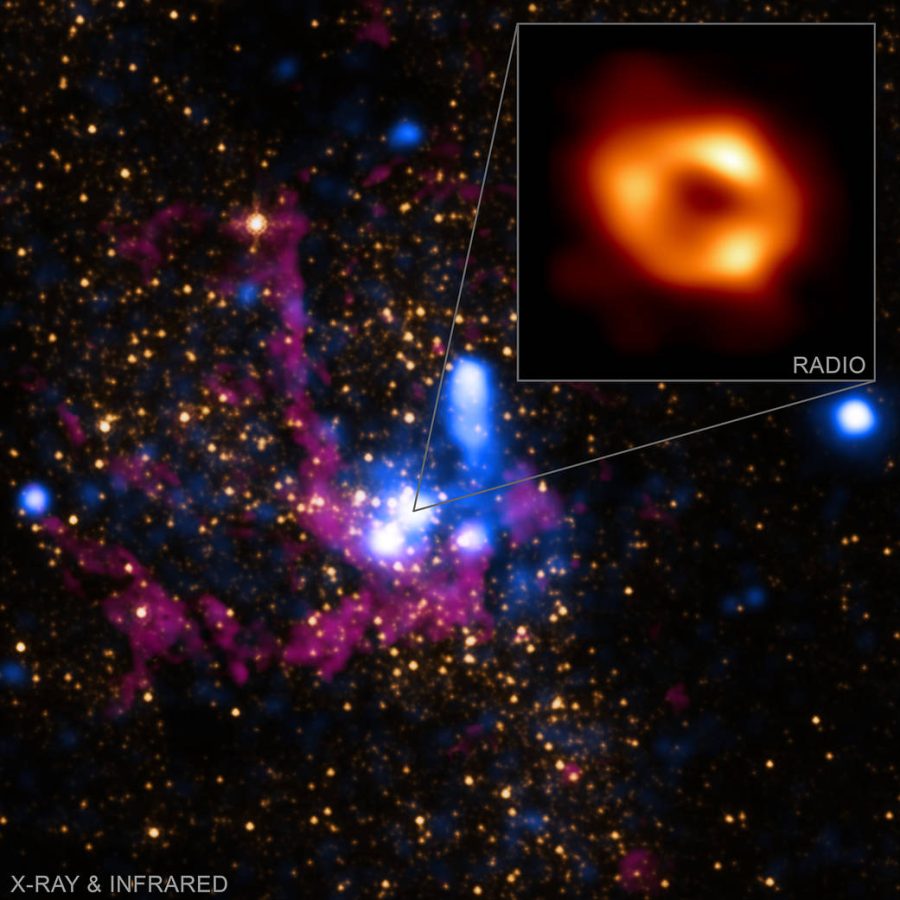Illinois scientists contribute to groundbreaking black hole image
An image of the Milky Way’s black hole taken by the Event Horizon Telescope. Professor Charles Gammie is a part of the Event Horizon Telescope team who captured images of the black hole Sagittarius A on May 12.
May 25, 2022
Last updated on Oct. 21, 2022 at 03:59 p.m.
For the first time, scientists were able to capture the image of Sagittarius A* — the supermassive black hole at the center of our galaxy. Among the hundreds of dedicated scientists involved in this monumental event were professors and graduate students from the University of Illinois.
Following the groundbreaking image of the Messier 87, or M87*, black hole captured in 2019, scientists used some of their findings to help understand and capture the Milky Way’s Sagittarius A*. On May 12, the Event Horizon Telescope team were successful in capturing the first image of Sagittarius A*. Part of the Event Horizon Telescope team is Charles Gammie, an associate professor of astronomy and physics at the University.
To explain how the process works, Gammie compared attempting to photograph the black hole to a dog chasing its own tail.
“It’s moving around as we try and take its picture,” Gammie said. “It’s like if there was a dog in your backyard and you’re trying to identify what the breed is. M87* is a big dog, it’s sort of posing there, maybe we’re just looking at its behind but at least you know it’s there. But Sagittarius A* is like a dog chasing its tail, and you know that makes it much more difficult to capture the image and understand what the data means.”
Get The Daily Illini in your inbox!
Gammie said part of his role with the Event Horizon Telescope team was to devise interpretations of the imaging.
“My group’s role is to try and understand what the image means and give a physical interpretation,” Gammie said. “The way we do that is by building numerical models and running them on the largest available supercomputers and then comparing the models to the data using various statistical techniques.”

Part of Gammie’s team is Abhishek Joshi, a graduate student in physics. While he found black holes to be interesting, it was not his central research interest, nor did he ever expect to be part of such a groundbreaking scientific discovery.
“It’s very easy to look at an image of a black hole as a simulated image on a computer,” Joshi said. “But in grad school, I realized to actually observe it is truly a phenomenal feat. It’s absolutely insane how much thought went into actually taking a picture of the black hole. To give some context, the telescope is so powerful it’s equivalent to observing a quarter that was placed on the moon.”
Joshi noted the difficulties associated with creating images of black holes, such as how their gravitational pull warps light in ways unfamiliar to most people.
“You can simulate a black hole with mathematical equations, and then you effectively can get a simulation of how the plasma moves, but that doesn’t give you the whole thing,” Joshi said. “For a black hole, the gravity is so strong it bends light in weird ways. If there was a black hole and I had a lightbulb behind it, some of the light rays will fall into it and get absorbed but some would bend up and over towards you. So you could see something even if I put it right behind the black hole. These complicated effects need to be modeled mathematically and so I helped in generating these simulated images.”
Because of the massive size of Sagittarius A*, scientists had to use multiple radio telescopes across the globe to capture enough data, then worked to combine the data to accurately observe the object. While the bulk of the collaborative computing was done using the Frontera supercomputer at the University of Texas, some work of the Illinois team was done on campus.
“Perhaps not as extensively as the Frontera supercomputer for the final product, but a lot of the testing part was done here (at Illinois), I mean a lot of my work is done on the local nodes here,” Joshi said. “We have professors in the department of astronomy who also work on taking observations with that telescope, and they’ve been there and actually handled it in the South Pole.”
However, capturing the image did not come without its challenges.
“It was a very challenging task, because it is very variable,” Joshi said. “By that I mean that the image itself changes very rapidly so to be sure that you get a proper image there are a lot of checks needed to be done to make sure that there is no scientific inaccuracies in the analysis.”
Gammie also noted the additional challenge of getting hundreds of people with different backgrounds around the globe trying to work together.
“There’s always a lot of push and pull inside the collaboration with interesting personalities, and I would say that 95% of that has been positive and it’s an opportunity to interact with people from around the globe,” Gammie said.
Joshi also felt it was surreal to be working with many talented scientists, including here in Illinois.
“I really like the place, the University of Illinois’ physics department in particular is one of the largest in the nation for Ph.D. students,” Joshi said. “I have to mention that the department is very supportive towards grad students. It was really welcoming.”
Gammie emphasized that this discovery isn’t just about making scientific progress.
“The major impact is in the public perception of science,” Gammie said.
This sentiment was echoed by Joshi.
“These scientific results don’t have any immediate profitable impact,” Joshi said. “The fact that you can read these stories and even younger kids, they can learn about what scientists do, and push them to try to learn more about the subjects that they’re interested in. That inspires children to hopefully take the step for the future.”
On inspiring children, Gammie’s team had coincidentally scheduled an outreach program with the University Primary School the same week the image was taken. They talked about black holes to the students ranging from second to sixth graders, some of whom are children of faculty.
“It was a wonderful experience,” Joshi said. “They are so insightful and asked many questions. We got to do a fun little outdoor activity where they simulated a black hole image. The curiosity that they show is far more than what adults show, it was inspiring.”






